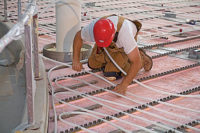Onward and upward at NCWA.

Scott Robertson has been a fixture with the North Central Wholesalers Association since 1984. He would come to the association’s annual event with his grandfather, John Robertson, and quickly hit the floors, building relationships so when he was ready to take over Ohio-based Robertson Heating Supply ( Supply House Times’ 2009 Wholesaler of the Year) he would be properly prepared.
Robertson, soon set to take over as NCWA president from John Strong, recently spoke with Supply House Times about his vision for growing the association.
Supply House Times: The NCWA recently went through a transitional period with President John Strong (Economy Plumbing Supply) and the hiring of Executive Director Terry Shafer. How do you plan to build on that period?
SR: My game plan is to continue the momentum on the changes and improvements that we’ve already begun. Terry Shafer is already the director of Southern Wholesalers Association and he’s familiar with running a regional association. He’s tried some ideas at SWA that are slightly different than what maybe we’ve tried in the past. What we’re doing is sort of experimenting with some of the successful things that Terry has done at SWA that we’ve never tried.
One example (at the annual NCWA meeting in June) is the manufacturers’ appointments at the tables vs. the former venue, which was tables in a big room where a (wholesaler) could walk by and if no one was standing there, they could starting talking until someone else comes up and starts talking. The format we went to was a formal one that the buying groups like Embassy use. You now have a dedicated 10-minute session and you have privacy and concentration.
Supply House Times: NCWA champions having distributor tours for its members. How will you balance the benefits for members against distributors giving away secrets to the competition?
SR: Our distributor tour is one, if not, the highlight of the entire year for an NCWA member. We’re getting to go to somebody else’s place and see what they do, how they do it and see it in action. You can’t help but walk away with a handful of awesome impressions or ideas that you can consider for your company.
I would think less than 25% of the distributors are that guarded that they don’t want to share all their good stuff. I would say with NCWA, it’s less than 25%. Most of us in NCWA - although we certainly compete - are going to show you and tell you how we operate. I’m going to show you our efficiencies and how we do them. To some extent it’s for the greater good of the whole industry, as long as I’m not getting too personal with you as my competitor. At the end of the day, we are in the same industry and that’s how 75% think.
Supply House Times: Numbers at your annual meeting showed a gain in momentum. Which markets in the region can companies make even more gains in the next few years?
SR: We were comparing (Industry Insights Principal) Tom Noon’s 2012 Operating Performance Review, an economic study of 2011 vs. 2010, and it showed 2010 was either the second- or third-worst profitability year in the last 15 years. 2011 was certainly an improved year for our association over 2010. That doesn’t mean 2011 was the year we all wanted to have, and it’s certainly not where we want to stop. The economy is growing and it is bouncing back. Distributors did tighten up their businesses in 2008 and 2009 to reflect the economy and reflect a sales decrease of 5% to 15%, depending on how much new construction they did. The benefits of that are in subsequent years - when you’re still running lean and mean - now you have sales growth of 6% to 8%.
In our region (Ohio, western Pennsylvania and Michigan), new construction starts are up 10% to 15% over last year, but that’s from a decrease of 50% from its highest point. Yes, it’s up, but it’s still down.
The other thing happening is we’ve gotten better at diversifying our businesses. We as distributors had to become better at the remodeling business. If people are going to stay in their houses longer that means they’re more likely going to remodel their homes if they can’t afford to sell. Many of us spruced up our showrooms and made them attractive. Some of us had to get into more commercial plumbing because that sector, especially how it relates to government (business), is big volume.




